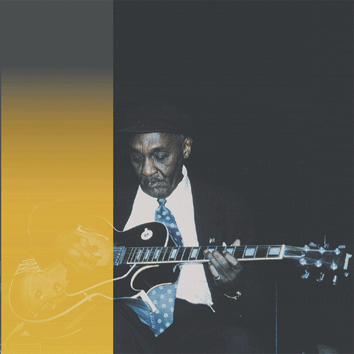
Al Casey - A Tribute to Fats Waller - CD jp 1044
Al Casey guitar
Red Richards piano
Jan Jankeje bass
Imre Köszegi drums
Titles: It Don 't Mean A Thing,Squeeze Me, Holey Moley, Jit It, Like it Ji's, Cute, After You've Gone, Just the Blues, Honeysuckle Rose How Long Is This Been Going On, Cheek to Cheek
AL CASEY 15.9.1915 - 11.9.2005 Renowned
for his long collaboration with Fats Waller, Al Casey towers alongside
the finest acoustic guitarists of the swing era, boasting a subtly
powerful presence that flourished in intimate musical contexts. Born
September 15, 1915, in Louisville, KY, Casey was a child prodigy who
first adopted the violin, briefly moving to the ukulele before zeroing
in on the guitar, which he studied at New York City's DeWitt Clinton
High School. He joined Waller while in his mid-teens, recommended to
the legendary pianist by his uncles, who met Waller while on tour with
their gospel group the Southern Singers. Waller insisted Casey remain
in school and earn his diploma before he could join the group
full-time, but the guitarist was a fixture of recording sessions from
the early '30s onward, and even joined Waller on tour during extended
holiday breaks. Casey remained with the group until Waller's 1943
death, appearing on more than 200 classic swing sides; the famous blues
number "Buck Jumpin'" took shape after Casey appeared late to a gig,
prompting Waller to single him out on-stage and invite him to play a
solo. The result was so electrifying that it was later captured in the
studio.
Casey also recorded with trumpeter Louis Armstrong,
singer Billie Holliday, vibist Lionel hampton, and pianist Teddy
Wilson, even joining the latter's short-lived big band in 1939. After
Waller's passing, he played with pianist Clarence Profit's trio before
assembling his own trio, which headlined New York's Onyx Club for close
to a year before moving to the Down Beat. Around this time Casey moved
to the electric guitar, and in both 1944 and 1945 he was named the
instrument's top player in Esquire magazine's annual jazz poll; he
spent much of the decade to follow as a gun-for-hire, capped off by a
four-year collaboration with R&B saxophonist King Curtis initiated
in 1957. Casey briefly retired from music in 1961, working in a Xerox
copy shop before returning to performing, recording sessions in support
of singer Helen Humes and pianist Jay McShann. After another extended
period of retirement, he resurfaced in 1981 with the Harlem Jazz and
Blues Band, which remained his primary vehicle for the next two
decades; in 1994, he also cut his first headlining date, signing to the
Jazzpoint label for A Tribute
to "Fats". After a long battle with colon cancer, Casey died on
September 11, 2005, just days short of his 90th birthday.
(Jason Ankeny, All Music Guide)
A "Tribute to..." quite often strives to come as close as possible to the idol the tribute is intended for. Practically a cover version without a chance of attaining the original. jazzpoint records did not even try to do that. We picked musicians who want to pay their respects to "Fats" Waller without abandoning their very own styles.
One of them, Albert Aloysius "Al" Casey, guitar, born in Louisville, Kentucky on September 15, 1915, started off with violin lessons, switched to the ukulele, and finally to the guitar in N.Y. Although a graduate from Martin Music School he was content to play rhythm guitar to Thomas "Fats" Waller practically almost whenever he played with this exceptional musician and entertainer.
Al Casey played on nearly all of the many hundreds of "Fats" records, both themillion- selling hits and the big band recordings that received less attention. Not until after the death of "Fats" waller did he "shed his chrysalis" to become that spectacular butterfly that is the soloist Al Casey.
Within one year he topped the critics' and fan's Jazz polls of various US Jazz fan magazines and kept up there until the audience's tast switched to bebop. This fast rise from "rhythm serf" to guitar soloist was facilitated by the invention of the electric guitar. As a style-forming musician in the classical swing era, "Al" Casey - with the "single-note technique" he introduced - ranks with Lonnie Johnson, Eddie Lang, Teddy Bunn, Django Reinhardt, Irving Ashby, Tiny Grimes, Allen Reuss and Charlie Christian. The numerous Jazz concerts after 1944, published after the recording ban of the US trade union, show this single technique (more than) clearly. In this tribute to "Fats" Al Casey demonstrates the rhythm guitarist and the soloist in a well-balanced ratio.
The stride pianist Red Richards always felt drawn to "Fats" Faller. His solo recordings in the early fifties as accompanist to the Buck Clayton/Mezz Mezzrow All Stars in Paris provided him with ample opportunity to document this predilection on records. jazzpoint records has featured this world class pianist on several CD's as an accompanist (Benny Waters Plays
Songs of Love - CD jp 1039), as a bandleader (Swingtime - CD jp 1041), as a soloist (My Romance - CD jp 1042) and (Groove Move - CD jp 1045 with George Kelly, Doc Cheatham etc.)
Jan Jankeje has been jazzpoint's house bassist since the LP days. He was the backbone, the mainstay of the most varied groups, ranging from Dixieland bands and swing orchestras to modern and experimental Jazz. Although the latter styles do more justice to his enormous technique, the bass giant enriches the swing music presented here with some solos of real virtuosity.
Drummer Imre Köszegi from Budapest keeps his birthdate a secret, but as he graduated from Bela Bartok Conservatory as early as 1963 he can't be a youngster anymore. His many teaching obligations as well as the number of musicians he rattled his sticks and - preferably - swept his brushes for, would fill even the most voluminous booklet. These illustrious names include Benny Bailey, Wolfgang Dauner, Carmel Jones, Albert Mangelsdorf and Jimmy Woode as well as Attila Zoller and Frank Zappa. His recording sessions, not less than 16, include famous groups such as the Aladar Pege Trio. With a modern touch troughout, here he shows his qualities as a swinger.
(Dieter Antritter)
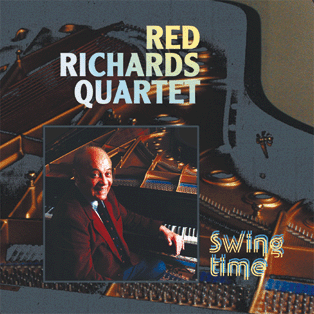
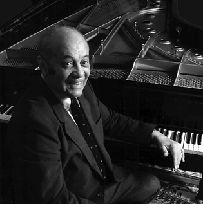
RED RICHARDS QUARTET - Swingtime - CD jp 1041
(Charles ‘Red’ Richards died on Thursday 12th of March 1998 while performing)
Red Richards Piano
George Kelly tenor-saxophone
Carline Ray bass
Clarence “Tootsie” Bean drums
Titles: Ounce to the Bounce, Once in a While, Black Butterfly, I Miss You, Them there Eyes, Soft Buns, There Will Never be Another
You, Go Red
Red Richards (1912 - 1998) is incredibly underrated as a pianist. Unfortunately, his versatility comes to light far too rarely” wrote Gerhard Conrad about Richards in Der Jazzfreund magazine. All the better that Richards has now taken the opportunity to demonstrate his versatility for the third time on the jazzpoint label (first as accompanying pianist to Benny Waters jp 1039, then on his solo CD ”My Romance” jazzpoint 1042). Red Richards and his N.Y. Quartet – it’s like home cooking, just pure, unadulterated swing. You can find more details about this band-leader in words and music on his solo CD jp 1042. This CD now has more than just one pleasant surprise in store. The first one is the lady on bass, although I refrain from categorizing
Carline Ray as a jazz-bassist (which, of course, she is), because the number of famous bands for which she has plucked the bass or guitar, played the piano or sung tunes range from Duke and Mercer Ellington to the classical composers Stravinsky and Bernstein. ”She works with the best and is respected by all” (M. Sudhalter: New York Post).
Clarence ”Tootsie” Bean comes from the Bermudas. He started his career, as a drummer, when he was only eight years old, and he was sought after as an accompanyist while he was still very young. From 1950 on we find him in New York, where he both studied (vibraphone) and gained experience from numerous appearances at blues and jazz festivals. In 1978 he joined the ”Count’s Men”, the successors to Count Basie’s Swing Machine.
George Kelly was born in Miami, Florida, on July 31, 1915. He came to the tenor sax at the age of 13 via the piano and alto saxophone. In the early thirties he had his own band in New York with Panama Francis on drums, with whose Savoy Sultans he played from 1941 to 1944. After that he joined Rex Stewart, and during the fifties and sixties he played with Cozy Cole, Buddy Tate, Jay McShan and many more, also touring Europe on several occasions. George Kelly is one of the world’s outstanding swing saxophonists. (Dieter Antritter)
One of the many pleasant things about the swing scene is the rediscovery of the great old men, jazz musicians who troughout their lives not only perfected their technique but also kept their feeling and their very own style. One of these personalities is Red Richards, an independent pianist, well-versed technically without being dominating, a congenial swinger. That he’s a singer, too, one could already find out in John Chilton’s “Who’s Who of Jazz”, which also lists his birthdate, October 19, 1912.
On the first record he was heard on he was as a member Campell “Skeets” Tolbert. After that he worked as a solo pianist, but quite frequently with exceptional musicians, too, such as Tab Smith, Bob Wilber and Sidney Bechet. But it seems that trumpeters appreciated his accompaniment even more, so we find names like Roy Eldridge, Bobby Hackett, Jimmy McPartland, Muggsy Spanier, Wild Bill Davison. Europe got to now him in the early fifties with concerts and records with the Mezz Mezzrow/Buck Clayton Band. He played the piano for the newly formed Fletcher Henderson Big Band (1957/58), and toured Europe several times with his own band, Saints and Sinners, as well as with the Harlem Blues and Jazzband.
GEORGE KELLY, a native of Miami, Florida, started his music career in 1924. After having studied the piano and saxophone. George formed his first group “Little George Kelly’s Cavaliers” as a teenager. In 1941, George left Miami and headed to NYC to join Al Cooper’s Savoy Sultans at the fames Savoy Ballroom in Harlem. While with Al’s group, George played backup for many celebrities including Ella Fitzgerald. George formed his own quintet in the 70’s named “George Kelly’s Jazz Sultans”. George has recorded with many of the greats: Sarah Vaughn, Andy Williams, Al Cooper, Tiny Grimes and Panama Francis. In 1950 he played on a Frank Sinatra television special. George is also widely known for his work as a composer and arranger and worked for: Cozy Cole Gene Krupa, Buddy Tate, Sarah Vaughn.
Piano vom Feinsten, doch gemeint ist nicht nur das Instrument, sondern der Pianist Red Richards: Stide, Jump, Blues, Balla-
den und das alles auch noch swingend. Eine den vielen Erfreulichkeiten der Swingrenaissance ist die Wiederentdeckung der Originale. Jazzmusiker, die sich im Laufe der Zeit nicht nur in ihrer Technik weiterenwickelt, sondern ihr Feeling erhalten haben. Eine dieser Persönlichkeiten ist Red Richards. Er ist erstmals auf Schallplatte als Mitglied von Campell „Skeets” Tolbert zu hören, arbeitete danach vielfach als Solopianist aber auch immer wieder mit so Ausnahmemusikern wie den Saxophonisten Tab Smith, Bob Wilber und dem King of Sopransaxophon Sidney Bechet. Aber auch mit Roy Eldridge, Bobby Hackett, Jimmy McPartland, Muggsy Spanier, Wild Bill Davison. In Europa wurde er Anfang der 60er Jahre bekannt durch Konzerte und Schallplatten mit der Mezz Mezzrow/Buck Clayton Band. Er saß auf dem Pianostuhl der neu formierten Fletcher Henderson Big Band , bereiste mehrfach mit seinen Saints and Sinners und als Mitglied der „Harlem Blues + Jazzband” Europa.
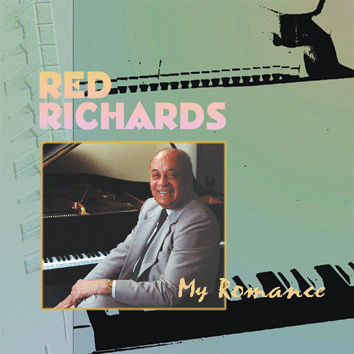
Red Richards - My Romane - CD jp 1042
Red Richards Piano and Vocal
Red Richards erhielt 1994 den „Grand Prix du Disque de Jazz” für die CD jp 1042 MY ROMANCE der jährlich nur einmal vergeben wird von der „Hot Club de France Fédération”.
Titles: I Wished on the Moon, Dorothy, I Would Do Most Anything for You, Drop Me Off in Harlem, I Should Care, Darn That DreamMy Romance, Idahoe, It’s Over Because We’re Through, Louisiana, Three Little Words
”My Romance” is piano at its best – and that not only refers to the instrument but to the pianist, too: stride, jump, blues, ballads, and all of them swinging. One of the many pleasant things about the swing scene is the rediscovery of the grand old men, jazz musicians who throughout their lives have not only perfected their technique but also kept their feeling and their very own style. One of these personalities is Red Richards. As the pianist on ”Benny Waters Plays Songs of Love” CD jp 1039 he contributed his own personal piano playing. So it was only natural to make a solo CD with Richards. Over eleven titles and a playing time of more than 52 minutes Red Richards offers a broad assortment of standard jazz numbers and his own compositions. That he’s a singer, too, one could already find out in John Chilton’s Who’s Who of Jazz, which also lists his birthdate, October 19, 1912. Born under the sign of Libra, his career as an artist was predestined, at least for the astrologers among us.
On the first record on which he played, he was heard on he was as a member Campbell ”Skeets” Tolbert. After that he worked as a solo pianist, but quite frequently with exceptional musicians, too, such as Tab Smith, Bob Wilber and the ”King of the Soprano Saxophone”, Sidney Bechet. But it seems that trumpeters appreciated his accompaniment even more, and so we find names like Roy Eldridge, Bobby Hackett, Jimmy PcPartland, Muggsy Spanier, Wild Bill Davison. Europe got to know him in the early fifties with concerts and records (Vogue) with the Mezz Mezzrow/Buck Clayton Band. He played the piano for the newly formed Fletcher Henderson Big Band (1957/58), and has toured Europe several times with his own band, Saints and Sinners, as well as with the Harlem Blues and Jazzband.
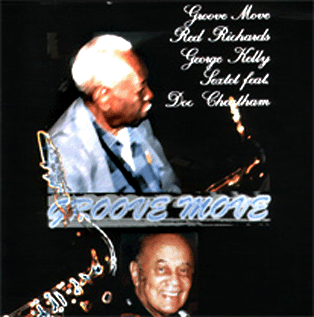
Red Richards, George Kelly Sextet featuring Doc Cheatham - Groove Move - CD jp 1045
Red Richards piano, vocal
George Kelly tenor-saxophone
Doc Cheatham trumpet, vocal
Al Casey guitar
Ole ”Fessor” Lindgreen trombone
Jan Jankeje bass
Imre Köszegi drums
Titles: Groove Move, I Wanna Little Girl Like Mama, Right On, Village Of Love, Up Stream, Idahoe, Stella By Starlight, Sunday, It’s a LittleThingThat Means So Much, Strike Up The Band, Sweet Sue - Just You, Lady Be Good
The musicians
As we are dealing with a band that is almost jazzpoint’s house combo it is only polite to start with the musicians we haven’t heard that much from yet on jazzpoint’s numerous SWING CD’s. First and foremost we have Doc Cheatham (trumpet and vocals) who started his career as a saxophonist but had to retrain for the trumpet, as his embouchure wasn’t right for the clarinet. His first big success in the thirties was with the famous big band of ”Hi-Di-Ho” man Cab Calloway. Thanks to his frequent performances in Europe, Doc is certainly no stranger on this side of the Atlantic. As a senior he has changed his trumpet technique, combining his still enormous technique with a round, full sound. His vocal interludes are funny and show clearly why he remains one of the most sought after attractions on the New York club scene (where he resides). His famous version of ”I Wanna Little Girl Like Mama” is included on this CD and demonstrates once more why it is not only because of his age that Doc is considered a real star in the U.S.A.
Trombonist Ole ”Fessor” Lindgreen is Danish. A big name in his home country, after this CD he stands to gain as much fame in other countries, too. His preference for R & B is revealed in his rhythmically accented solos. But he has always been attracted to the jazz traditionalists and still is today. This is documented by the many well-known names that he and his various bands have performed live or recorded with. What ”Fessor” likes most are pianists, and - in the person of Red Richards - he has one of the best.
Red Richards is a New York resident, too, but he is known literally ”all over the world” due to his travels to almost every country on the globe. He is a regular on jazzpoint CD’s, both as a soloist (My Romance jp 1042) and as a member of Benny Waters’ ensemble ”Plays Songs of Love” jp 1039 with his New York band and on the CD ”A Tribute to Fats ” jp 1044. Red Richards is an independent pianist, well-versed technically without being dominating, a congenial swinger.
Al Casey on the guitar is one of his accompanying musicians on this recording, as he was already on ”ATribute to Fats”. Al has been a reliable rhythm guitarist on hundreds of ”Fats” Waller recordings and became the top guitarist on the international jazz scene from 1944, and the winner of numerous jazz polls.
Also well-versed in his technique, and as swinging als always, is bassplayer Jan Jankeje, one of whose achievements is the discovery of Bireli Lagrene, is excellently supported on this CD by drummer Imre Köszegi.
As precise as clockwork one might have said in former times, but this would be an insult to Imre, because although clockwork may be as precise as Köszegi, no clockwork can swing the way he can.
Last but not least there is George Kelly, a musician’s musician who plays an unusually lyrical tenor saxophone, despite of his long-standing experience with Harlem dance palace bands. George Kelly contributed many compositions of his own to this CD, such as his jumping ”Groove Move” that lends its title to the CD and which gives each and every musician a solo. A completely different, tenderly aspirated piece is his composition ”Village of Love”. These two tracks demonstrate the wide breadth of expression and expressiveness of this congenial, modest tenor saxophonist.
(Dieter Antritter)
It seems that there are three prerequisites for being able to play such "beautiful" jazz: talent, practice, and a ripe age. These, at least, are the features shared by all the artists who came together for this session to show us what relaxed swing is all about.
There is a sort of surreal easiness, a harmony which pervades the atmos-
phere as it can only do when performers are playing together who know and like one another. Music for every day- and nighttime. The closing announce-
ment of a jazz program with a Harlem group in a similar setting and mood on Southern German Radio’s third program: ”Folks, that was real music for once” fits this recording exactly. For you who have purchased this CD there is no ”closing announcement”. You can listen in to this music again and again.